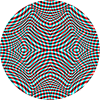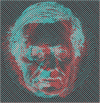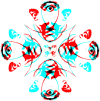On the Art of Binocular Rivalry
- PMID: 34888026
- PMCID: PMC8649479
- DOI: 10.1177/20416695211053877
On the Art of Binocular Rivalry
Abstract
Binocular rivalry has a longer descriptive history than stereoscopic depth perception both of which were transformed by Wheatstone's invention of the stereoscope. Thereafter, artistic interest in binocular vision has been largely confined to stereopsis. A brief survey of research on binocular contour rivalry is followed by anaglyphic examples of its expression as art. Rivalling patterns can be photographs, graphics, and combinations of them. In addition, illustrations of binocular lustre and interactions between rivalry and stereopsis are presented, as are rivalling portraits of some pioneers of the science and art of binocular vision. The question of why a dynamic process like binocular rivalry has been neglected in visual art is addressed.
Keywords: anaglyphs; binocular art; contour rivalry; graphics; lustre; photography; portraits; stereoscopic vision.
© The Author(s) 2021.
Figures























References
-
- Ades D. (2000). Dali's optical illusions. Yale University Press.
-
- Ades D. (2008). Camera creation. In Mundy J. (Ed.), Duchamp, Man Ray, picabia (pp. 89–113). Tate Publishing.
-
- Aguilonius F. (1613). Opticorum libri sex. Philosophis juxta ac mathematicis utiles [Six books on optics. For the use of philosophers and mathematicians]. Moreti.
-
- Alais D., Blake R. Binocular rivalry. MIT Press.
-
- Alais D., Blake R. (2015). Binocular rivalry and perceptual ambiguity. In Wagemans J. (Ed.), The Oxford handbook of perceptual organization. Oxford University Press.
LinkOut - more resources
Full Text Sources

